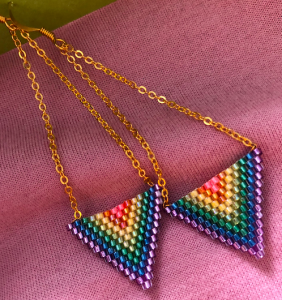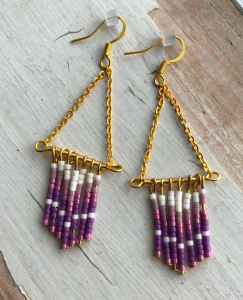In my first use of Twine, I created this small game with a team from the Digital Games and Learning class in the MET Summer Institute. Our game, Era, was about a cute dinosaur dealing with big issues. The game is a contemporary take on environmental action, where the non-binary dinosaur has to act in order to save the planet.

The choice of make a change or maintain the status quo kept the game lighthearted, but would allow players to access the main message of taking action.
To play the game, download this file and open in browser. Dinosaur Space Program (1).html
~ ~ ~
In my next Twine, I aim to weave my own narrative of beaded earrings with the creation of digital games as an interactive story of process. From the process of abstract imagined ideas to tangible products, I engage in learning that is transformative by developing a deeper understanding of myself through the creation and exploration new possibilities. The process of creating digital games and beadwork are similar through the processes of design, but functionally crafted in different ways.



“My earrings are complex” will juxtapose the design process of beaded earrings with digital games, from the perspective of Kafai and Burke (2015) that students learn through computational participation in “video game making [is] an unique, early channel for children to comprehend the social, economic, and civil power of making and sharing.” To play the game, download this file and open in browser. Her earrings are complex (1).html
References:
Kafai, Y. & Burke, Q. (2015). Constructionist Gaming: Understanding the Benefits of Making Games for Learning. Educational psychologist, 50, 4, 313-334.
Kafai and Burke (2015) argue that playing and making games combines the constructionist and instructionist methods of learning to provide a more inclusive and informative process of learning through creation. Kids learn from a system-based thinking approach, through their critical engagement with media and by engaging in the online participatory culture. Learning through game making can provide students with new media literacies where they learn computational skills through the concepts, practices and perspectives, academic content and social skills of collaboration, problem solve and participation and further their insight into their own personal process of learning.
Tran, K. M. (2016). “Her story was complex”: A Twine workshop for ten- to twelve-year-old girls. E-Learning and Digital Media, 13(5–6), 212–226. https://doi.org/10.1177/2042753016689635
Tran (2016) discusses girls (aged 10-12) involvement in game design as a form of literacy, the benefits for learning and the implications of how girls engage in game design. The interpretations of game design and the motives for design are dependant on the interests of the individual (pop culture, humour, shared hobbies etc.) however, engaging in game design provided an outlet of creation, connection and expression.
Analysis
Twine provides a platform to create trails of knowledge as pathways that split and converge. In the article by Vannevar Bush, “As We May Think,” the idea of elevating civilization by releasing the burden of information to digitally recorded trails of knowledge created “a new profession of trailblazers.” To think of this concept metaphorically, people became weightless as swim down a river, and despite feeling in control and unburdened, they are gently guided by the current. Subconsciously, they are guided by those who have come before along the trail and the path they create is in fact guiding their actions.
Hyperlinks create a mirage of control, where the reader only had choice over what is presented and therefore lacks the ability to follow their own path or blaze their own trail. Bolter in his work, “Hypertext and the Remediation of Print” supports this notion that “letting the reader choose links only gives the illusion of control, which is really withheld from the reader. If authors prescribe links, they deny the reader the choice of making her own associations, so that a printed novel or essay actually gives the reader greater freedom to interact with the ideas presented.” In the creation of a Twine, the pathways prescribe the type of interaction the player will have with the content. This connects with Engelbart’s work, Augmenting Human Intellect: A Conceptual Framework, where he states that “If there is any one thing upon which this ‘intelligence depends’ it would seem to be organization” (1962). The organization of hypertext can be related to trees of information, similar to the nodes and pathways of Twine. By connecting ideas through hyperlinks, these pathways denote a series or sequence of ideas to organize the thought processes. The popularity of hypertext is demonstrated through how it infiltrates oral language, linking ideas and changing the relationship between the reader and the text, but begs the question: is it possible to uncover new information and go against the current of the hyperlinks?
References:
Bolter, J.D. (2001). Writing Space: Computers, hypertext, and the remediation of print (Links to an external site.). Mahway, NJ: Lawrence Erlbaum Associates, pp. 77-98.
Englebart, Douglas. (1963). “A conceptual framework for the augmentation of man’s intellect (Links to an external site.).” In Hawerton, P.W. and Weeks, D.C. (Eds.), Vistas in information handling, Volume I: The augmentation of man’s intellect by machine. Washington, DC: Spartan Books. Available (as “Augmentation of human intellect: A conceptual framework”)
Bush, V. (1945). As we may think. The Atlantic Monthly, 176(1) (Links to an external site.), 101-108.
That was fantastic Emily.
You had me at the start as soon as you quoted Seymour Papert. He has helped fill in the gaps that made me feel like my teaching style is successful. I tent to be a maker at heart, and watching you weave a tale of sharing, belonging and mastery, helped remind me what makes our profession so fulfilling. I’ll always love teaching math but it is the making of great people through building a sense of community that makes me long to be back in the class right now, even with summer around the corner.
Great job.
Thanks for the thoughtful comment Ryan. It is hard to spend so much time away from our communities during our present Covid crisis. I am looking forward to learning together through play with my students rather than being mediated by our computer screens one day soon!